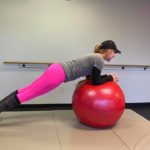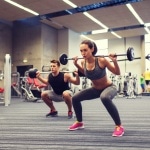
March 2021
Does Higher Protein Intake Boost Strength in Older Women?
For several years now, studies have shown that increased protein intake helps older people slow the rate of age-related muscle mass loss (sarcopenia.) This was true even as participants were dieting to lose weight. Resistance training (RT), a recognized stimulator of muscle strength and mass, has been studied in the older population with positive results. But a weight loss program without RT tends to cause some muscle loss in addition to fat loss. With RT, a weight loss program actually enhanced physical performance in older adults as muscle was maintained while fat was lost.
A study wanted to see if an emphasis on increased protein intake, without supplements or provided meals, while in a 6-month RT program lost weight maintained or built muscle and improved performance on standardized functional tests.

Those who completed the program lost 9.2% +/- 4.8% of their initial body weight with 42.6% meeting the 10% weight loss goal.
While no statistically significant differences between groups were found, the C group had more who lost over 10% of their weight. Everyone lost body fat but no group differences were found.
The two exercise groups improved strength similarly. They also mades substantial improvements in function.
In sum, increased protein intake may not make that big a difference for older women doing RT. But RT definitely does.
MSSE Jan. 2021
Heavy Lifting is Safe and Effective After Breast Cancer Surgery
After surgery for breast cancer, women often need adjuvant chemotherapy for a period of time to knock out any cancer cells missed by the procedure itself. These treatments have their own adverse effects on health and physical function. As with any surgery, recovery involves restoration of muscle mass, strength and function; adjuvant chemotherapies add more insult to the surgical injuries.
A Scandinavian study explored the benefits of a 12-week high intensity, twice-weekly lower body strength program on 55 women being treated for Stages I-III breast cancer after surgery. One group served as a control while the other did four sets of 3-5 reps on a leg press machine. The whole routine took less than 20 minutes including warm up and cool down. The lifts were done with very slow and controlled eccentric (when you let the legs return to the flexed position after straightening them.)
They found the protocol was safe and that those in the lifting group improved strength similar to studies of healthy adult women; these improvements carried over to such functional performance measures of a 6-minute walk test, the 30-second chair sit to stand, and the stair climbing test.
Other studies have also found that training does not impact risk of lymphedema. All but one patient completed the program. And those in the control group experienced the typical declines in strength, muscle mass and function.
MSSE June 2020
Tid Bits
Over 200 years ago, someone determined that our average body temperature was 98.6 degrees Fahrenheit. Now, with everyone taking temperatures upon entry to nearly everywhere, more recent studies show the average has dropped about one degree to 97.5 degrees. Even an anthropological study of a hunger-gatherer tribe in the Amazon found that average body temperatures are now 97.7 degrees. DukeMedicine Health News Jan. 2021
Nutrient timing is a sports nutrition concept designed to help athletes eat properly around their training and competition schedules. But it might help with weight loss, too. A Vanderbilt University (shout out to my alma mater) our “biological clock” might regulate how food is processed, suggesting that fat burning might be clock dependent. Subjects had 2 sessions of 56 hours in a metabolic chamber with all meals provided. Lunch and dinner were at constant times. Their third meal was either at 8 a.m. or 10 p.m. When more calories are consumed later in the day, less fat is burned. IDEA Fitness J Nov-Dec 2020
How hard can you go? A Norwegian study of 1567 men and women (avg 72.8 yrs) compared the longevity benefits of high-intensity interval (HIIT) to moderate-intensity continuous (MICT) training, all supervised, over a 5 year span. As you’d expect, both exercise programs benefitted but the HIIT group had a slightly lower risk of dying (absolute risk reduction of 1.7% vs 1.2% for the MICT) compared to the controls (CT: encouraged to abide by recommended physical activity standards.) Interestingly, the HIIT had a 2.9% risk reduction compared to the MICT. Apparently many of the CT actually preferred HIIT; as a group they were somewhere between the HIIT and MICT. In sum, HIIT trended toward lower mortality relative to CT and MICT. BMJ Oct. 2020















